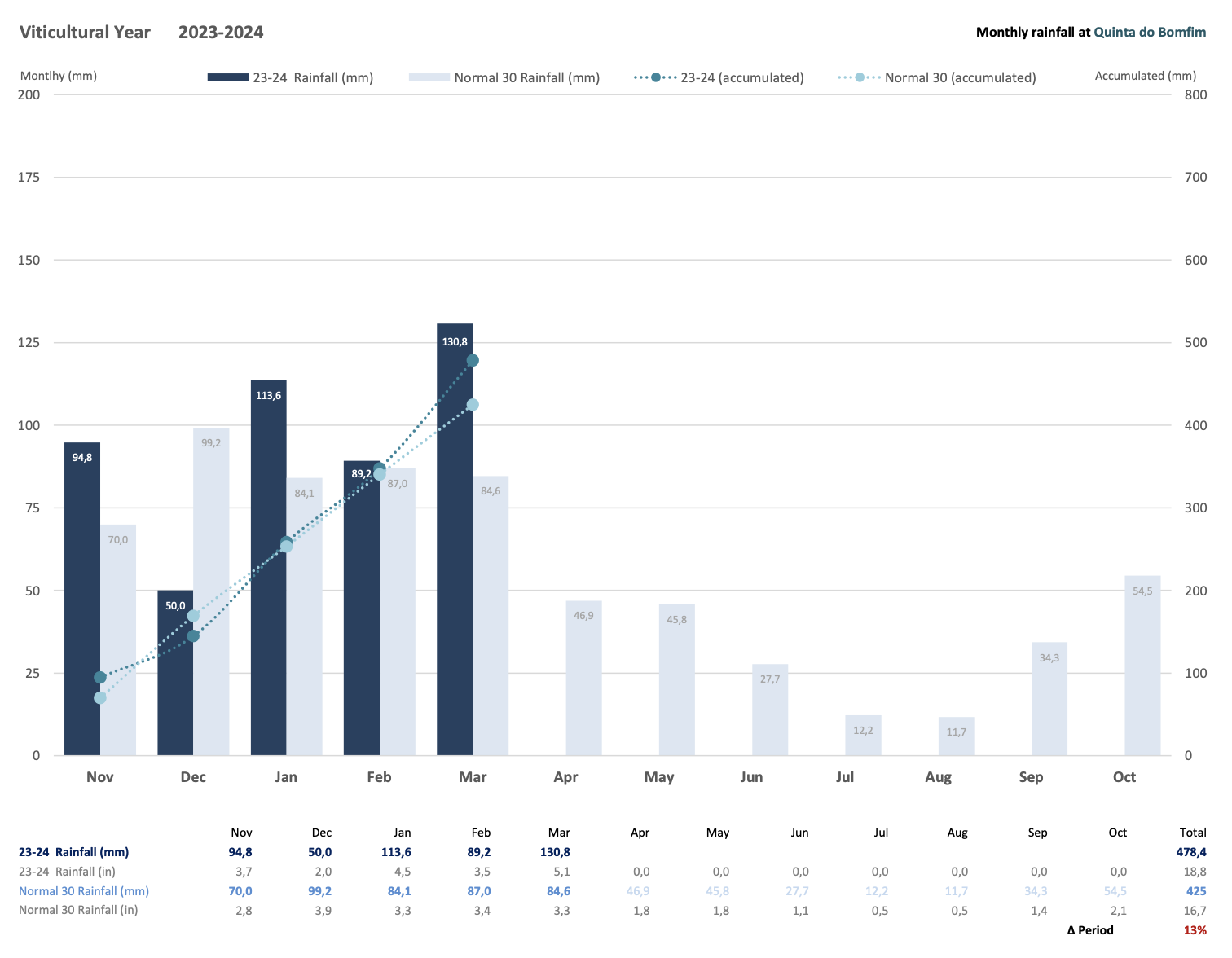
Viticulture Bulletin – Winter 2024
November 2023 – March 2024
Synopsis
This was the second wettest winter of the last decade in the Douro with 478.4 mm of accumulated rainfall at Bomfim (considering the period from November 2023 to March 2024). Interestingly, this is just 1.2 mm above the accumulated total of the previous winter, which was, however, concentrated heavily in the first half of the season with not a single drop recorded in February and almost four times below the average during March. By contrast, rainfall was evenly spaced out over this winter with every month – bar one – during the season recording above average rainfall. This position is well illustrated by the fact that we had reached - at the end of December - 31.46% soil water content (Bomfim probes) which equates to 95% of field capacity - the maximum amount of water that the soil can hold in a given location.
Fig.1: Quinta do Bomfim – Viticultural Year 2023/24 – Monthly rainfall.

Rain was abundant in November, the first month of the viticultural cycle: Cavadinha recorded 67% above the monthly average (133 mm), whilst both Bomfim and Malvedos had just above 30% more precipitation than the 30-year average. To underline this bounty of rain, the soil probes at Quinta do Bomfim measured the highest soil water content of the last three years for the month of November. On a less positive note, the month was reported as ‘very hot’ by the Portuguese Meteorological Office (IPMA) – the second hottest November since 2000, and this was aptly reflected in the unseasonably warm temperatures experienced in the Douro with Bomfim, Cavadinha, Malvedos and Vale Coelho all recording temperature deviations from the 30-year average of more than 2°C.
Quinta da Fonte Souto in Portalegre, Alto Alentejo also benefited from generous rainfall, 62% above the monthly average at 186.5 mm. Fortunately, temperatures were close to normal.
In December, temperatures across most of the Douro were closer to the monthly average, in fact just a fraction below in all but two of our quinta weather stations. December rainfall was the only exception to the rule of this winter, falling short by about 50% in virtually all our quintas. As in the previous month at Fonte Souto, temperatures were also close to normal, whilst rain was almost three times less than what could be expected for December.
We were starkly reminded of the climate crisis when January 2024 was reported by several world meteorological services as the warmest January since records began in 1850: 1.66°C warmer than the pre-industrial average (1850-1900). The IPMA (Portuguese Met Office) recorded a heatwave during the last third of the month, the most pronounced in January since 1941. Thankfully, rainfall was above average, and this was the case across all our vineyards – as recorded by the nine weather stations we have in the Douro. Quinta dos Canais topped the scales with 60% more accumulated rainfall than the monthly average. The scenario was similar in Portalegre with Quinta da Fonte Souto recording well above average temperatures and rainfall.
Since the end of December (2023) we have recorded climate data at Casa de Rodas and henceforward we will share relevant information from this property in the Monção-Melgaço subregion of the Vinho Verde DO. As elsewhere in Portugal, temperatures for January were above the monthly average, although by contrast with all our other weather stations (Alentejo and Douro) below monthly average rain was observed, albeit still quite reasonable at 122.6 mm.
February was another unseasonably warm month, the hottest February in Portugal since 1931. The biggest temperature departures from the normal were recorded at Cavadinha (+3°C) and Malvedos (+2.3°C). Above average rainfall recorded by all SFE weather stations, across the three regions – Alentejo, Douro and Monção-Melgaço, helped to mitigate matters, this being most visible in the Minho at Casa de Rodas (194 mm, or 55% more than the 30-year average).
Temperatures were close to normal in March, across the three regions where we farm vineyards and the month brought abundant rain. In the Douro, Cavadinha and Vale Coelho registered the most significant volumes (both +80%) but it was Portalegre and Monção-Melgaço that took joint top honours with Fonte Souto recording almost three times the monthly average and Casa de Rodas more than three times the 30-year average, respectively, 179.9mm and 272.4mm!
The generous precipitation observed across the whole country through March meant that the drought status, which persisted in some areas of southern Portugal officially ended.
Unsurprisingly, soil water content (measured by the probes at Quinta do Bomfim), continued high, practically at or near field capacity. Hitherto (since we began to take regular readings), this is the year showing the most favourable soil moisture levels and it was the winter in which (water) field capacity was reached quickest and maintained throughout the period, right up to the beginning of spring (see figure 2, below).
Fig.2: Quinta do Bomfim – Viticultural Year 2023/24 – Soil Water Content.

Budbreak
This year, budbreak at Bomfim began March 14, which is very close to the average, and on March 19 at Quinta do Ataíde, which is about a week early.
Fernando Alves, Miguel Potes and Joana Valente · June 12th, 2024


